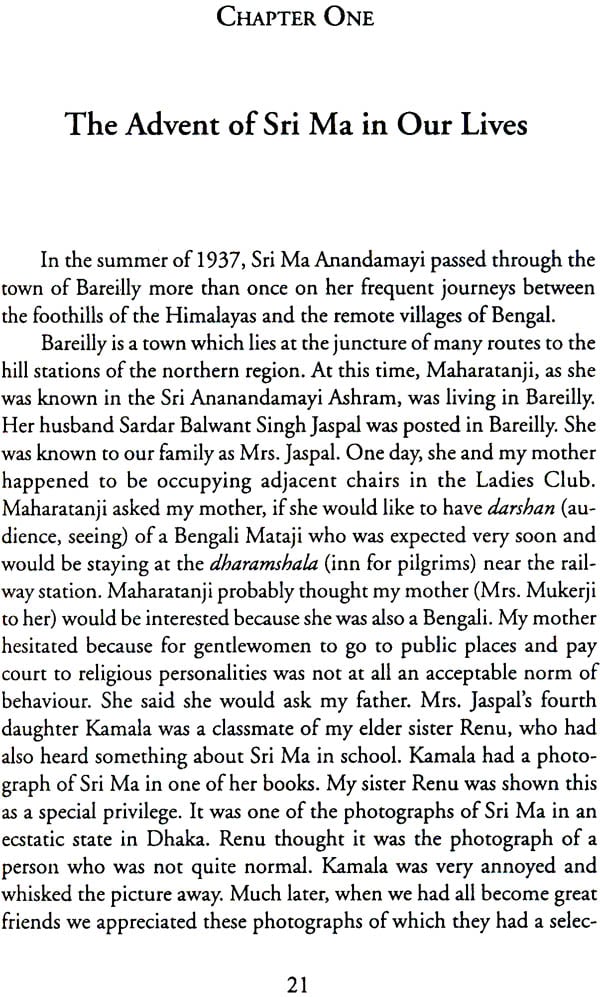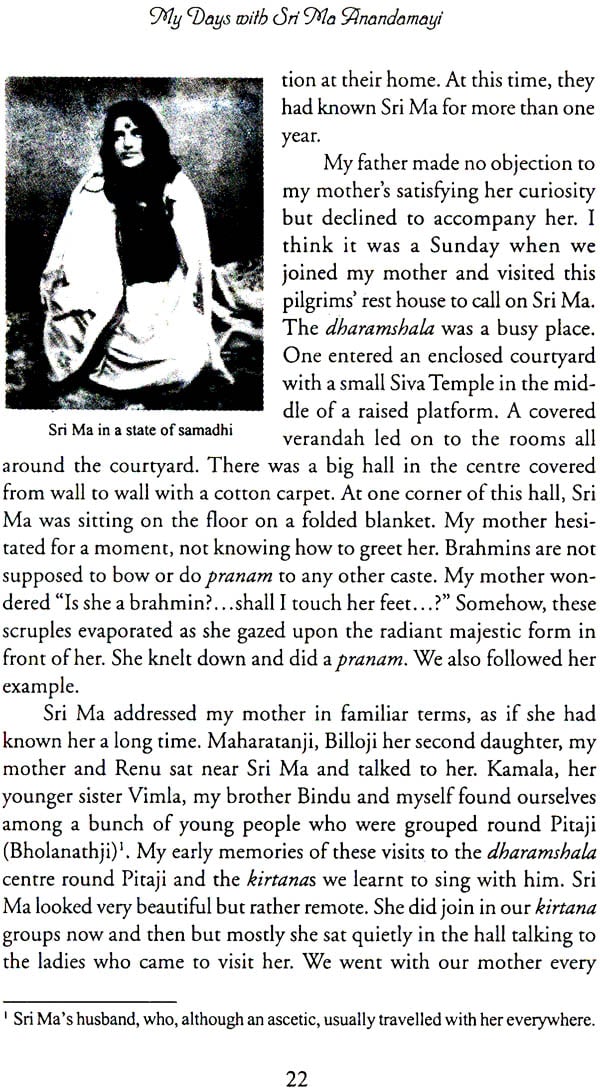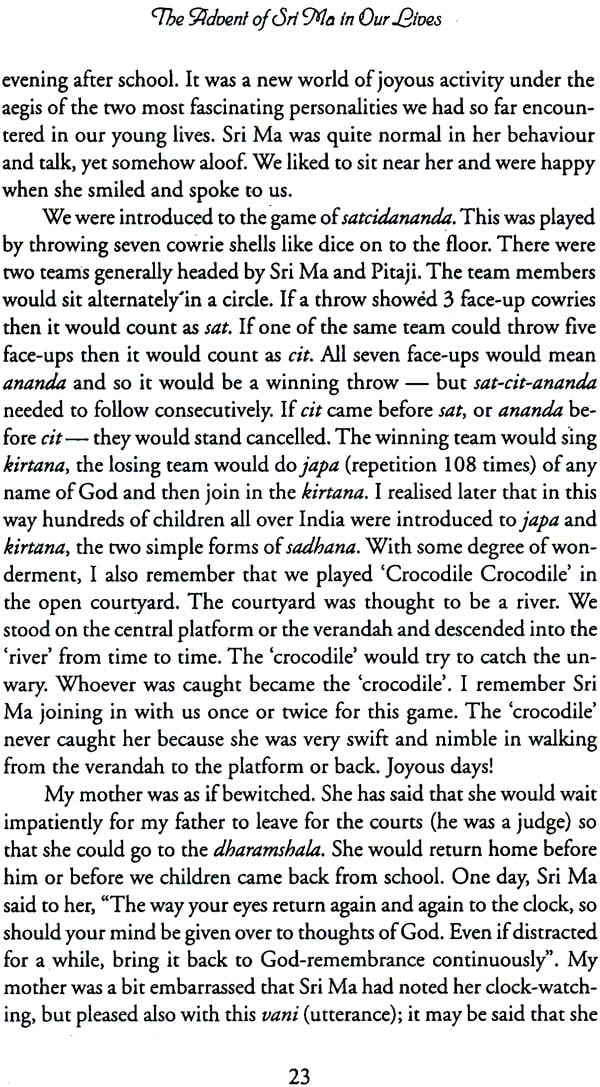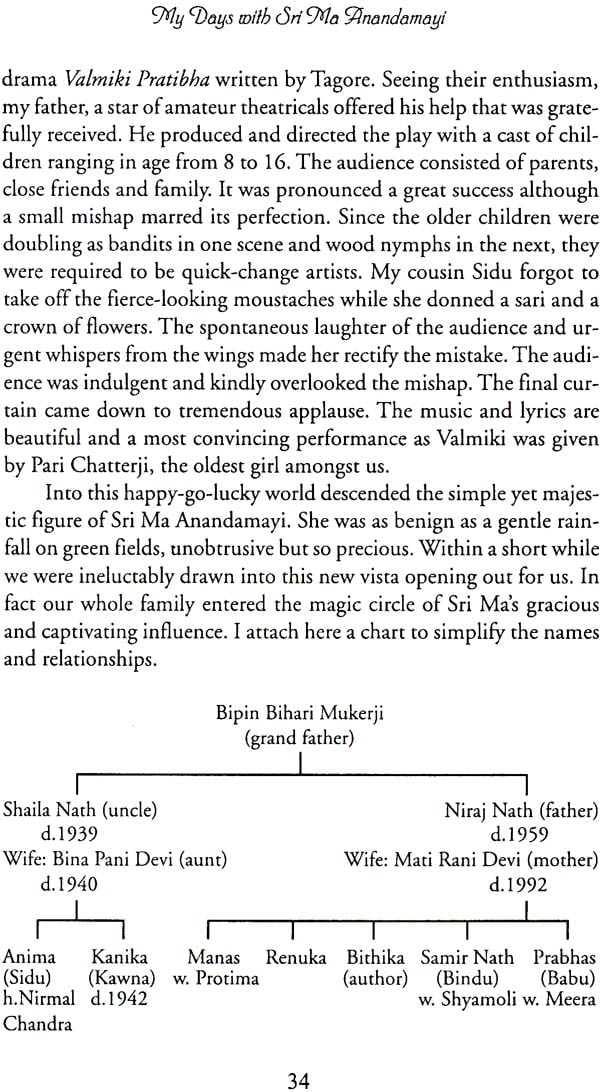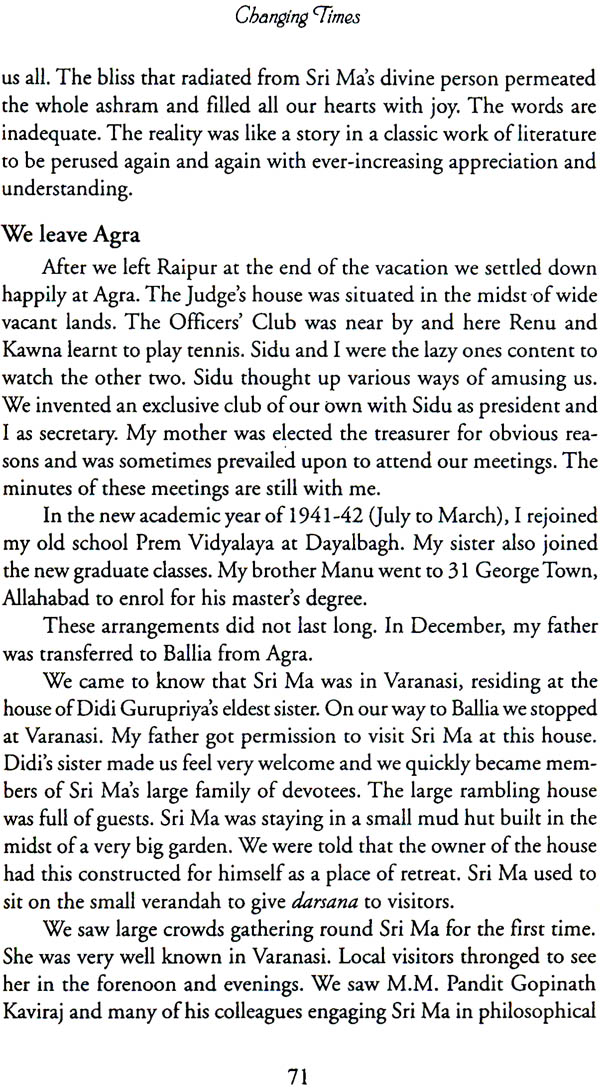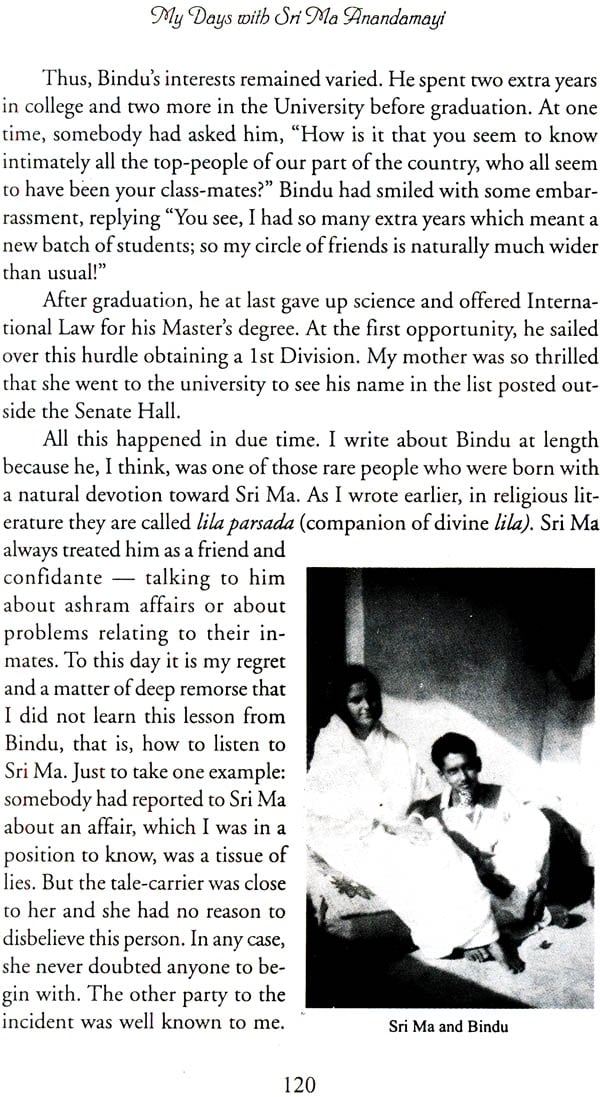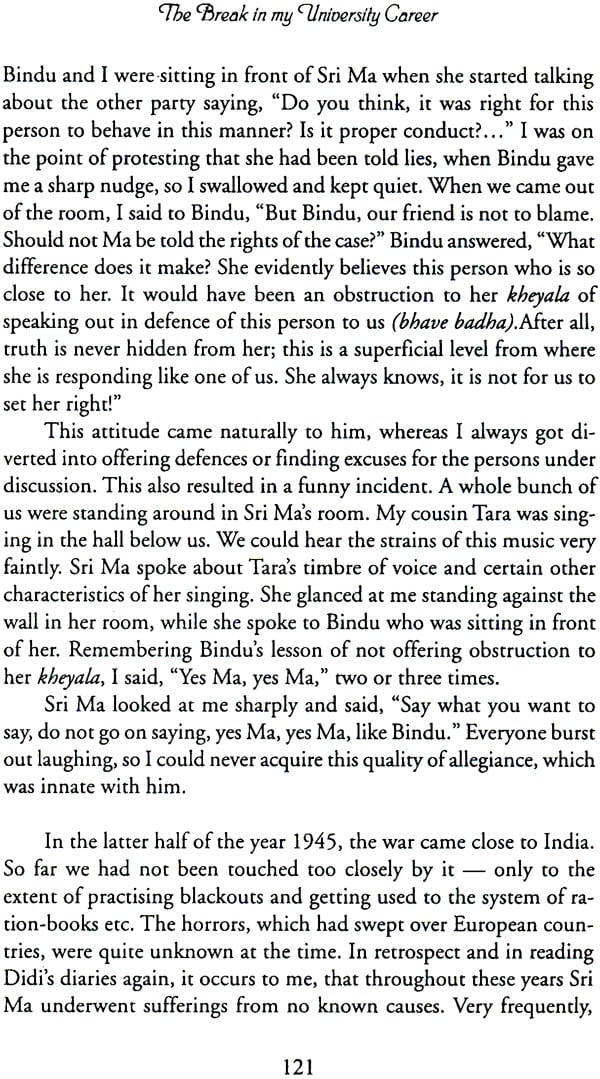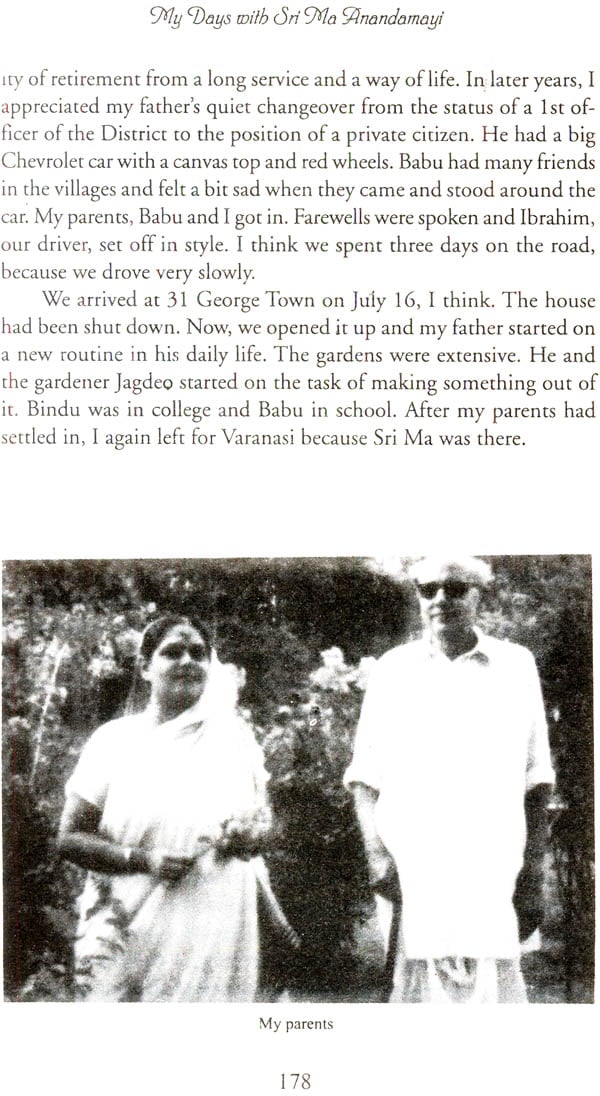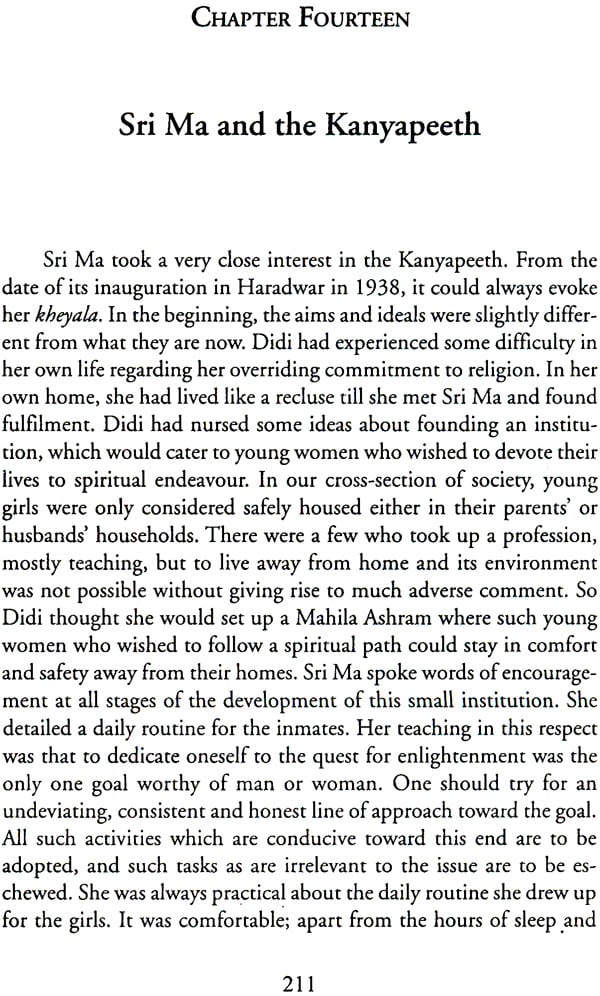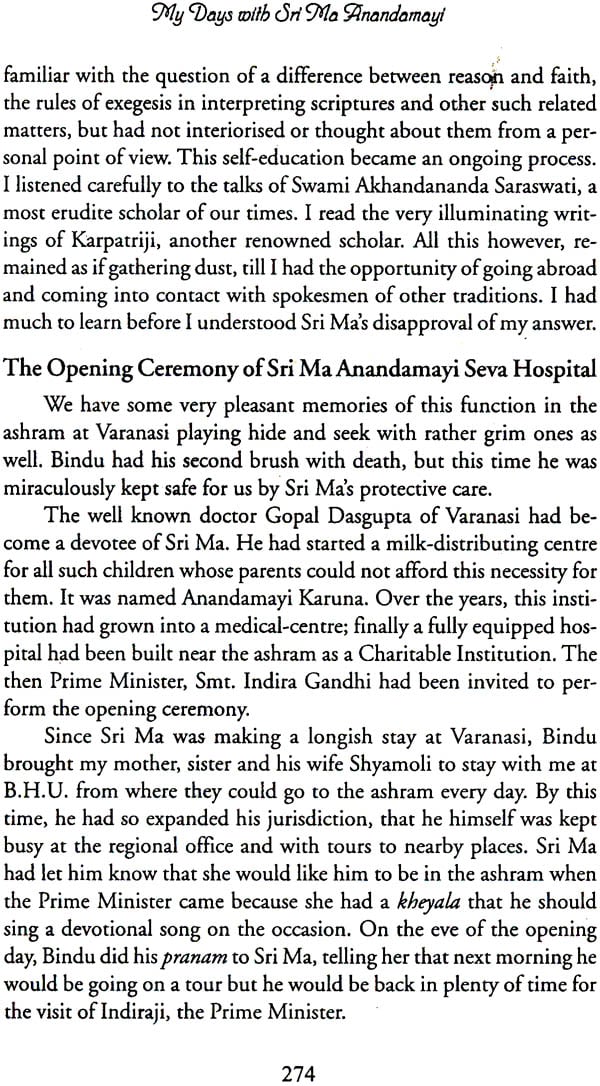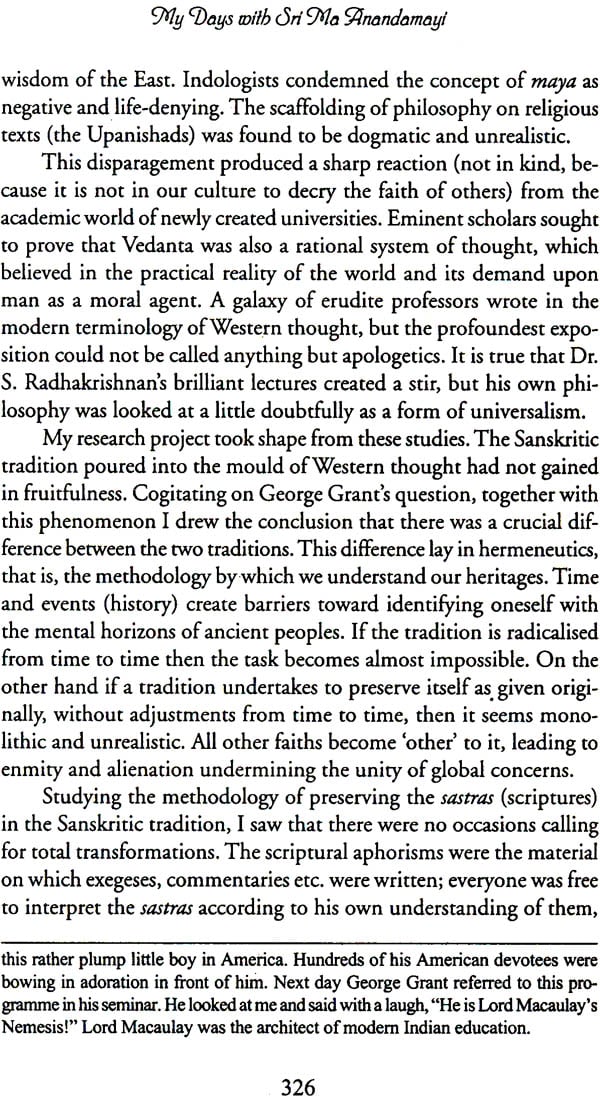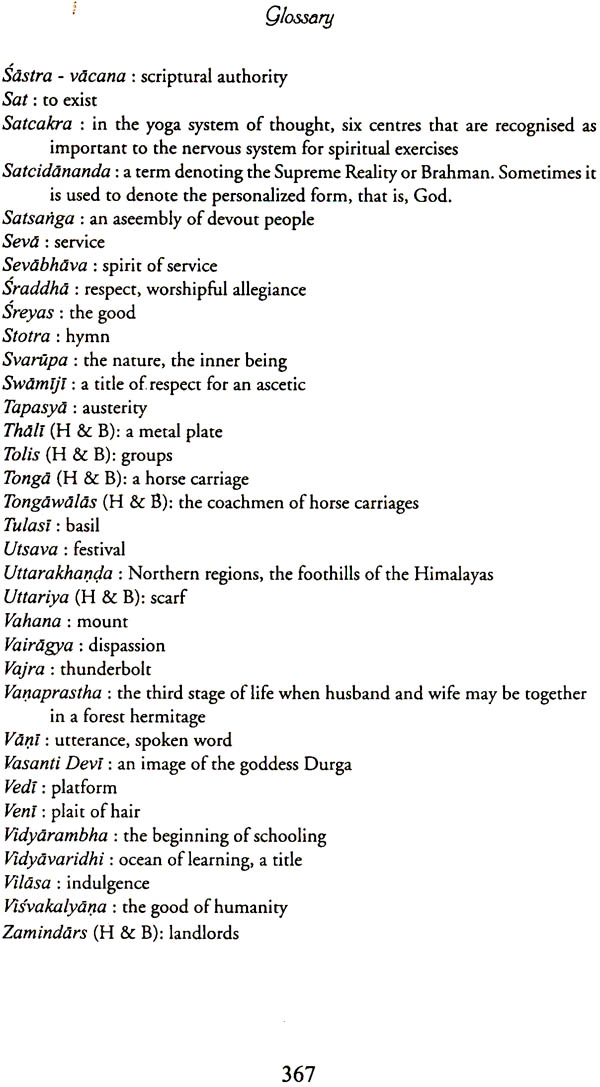
My Days With Sri Ma Anandamayi
Book Specification
| Item Code: | IDE796 |
| Author: | Bithika Mukerji |
| Publisher: | Indica Books, Varanasi |
| Language: | English |
| Edition: | 2002 |
| ISBN: | 8186569278 |
| Pages: | 367 (B & W Illus: 43) |
| Cover: | Paperback |
| Other Details | 8.5" X 5.5" |
| Weight | 460 gm |
Book Description
From the Jacket:
"She would say in humility, 'I am a little girl only. I have not been educated at all', but I have heard the effervescence of Veda-Vedanta pouring forth from her divine lips."
Mahamandaleswar 1008 Sri Vidyanandaji Maharaj, Kailash Ashram, Rishikesh
For a span of more than fifty years Sri Ma Anandamayi dominated gracefully the spiritual horizon of India. The keepers of the Vedic heritage - the ascetics orders of India - were united in declaring her the quintessence of the Upanishadic Spirit. Eminent philosophers like Mahendra N. Sarkar and P.M.P. Mahadevan acknowledged her utterances as authoritative.
Much has been written about Sri Ma by erudite scholar as well as ordinary men and women. The present book is a lively and engaging account of Sri Ma's enigmatic personality from the point of view of a single devoted family. It is an intimate and moving study of personal commitments. Yet through the author's perspective an emerging modern society is glimpsed where orthodox rites, political upheavals, social changes create the shifting patterns of a kaleidoscope. Sri Ma and her entourage of visiting dignitaries, princes, scholars, village women and children, and renowned ascetics assume a three-dimensional image. According to Richard Lannoy, who has written the Foreword, the book is a valliant attempt at closing the distance between the known and the unfathomable.
"Trained in the highest rigours of academic discipline in renowned universities of India and Canada, Bithika Mukerji, being very close to Anandamayi Ma from early childhood, was able to observe from near rare dimensions of a surpassingly beautiful spiritual being. Her reminiscences of her days with the Mother consequently, have an authenticity, charm and insight difficult to come by.
(Manas Mukul Das, Professor of English, University of Allahabad)
1 have been a privileged witness to the gestation of this wonder- ful book. The personal memoir by a member of a distinguished fam- ily closely associated with Sri Anandamayi Ma for almost half a cen- tury, it is a uniquely intimate portrait.
The function of a foreword is to say briefly a few things about a book which the author cannot with modesty say herself. This is par- ticularly true here, for Dr. Bithika Mukerji is so modest that the book very nearly failed to see the light of day. Fortunately, persistent en- couragement, moral support and even a bit of good-natured badger- ing finally prevailed. Dr. Mukerji, already the author of a fine and authoritative biography of Sri Ma, A Bird on the Wing, was persuaded to return to her subject, but introducing a crucial new dimension to her several published accounts, namely her personal angle. For some- one so preternaturally disposed toward self-effacement - a self-con- fessed inveterate "propper-up-of-walls" at the very back of the sat sang hall - the prospect of advancing so far forward as to present a per- sonal, semi-autobiographical angle upon a figure she regards as be- yond the usual boundaries of human experience, seemed not only daunting but (1 hope 1 am not revealing a secret !) presumptuous. Of course it wasn't in the least presumptuous; it was a guarantee of au- thenticity. Thank goodness she had the courage to complete her story, for it is in its openly-admitted subjectivity that its vividness and im- mediacy are rooted.
Something very special happens in the pages of this book. Allow me to share with you what 1 believe to be the "hidden treasure" in store for the reader, and certainly the source of a revelation to me personally. A5 a photographer who spent months photographing Sri Ma in the Fifties, I always sought, basically for aesthetic reasons, to pay very careful attention to the total visual field, the context, the atmosphere (atman-sphere, as that word originated long ago) of Sri Ma's environment. Personally, I had eyes only for Sri Ma; but photo- graphically - I knew better than to isolate her from her setting, her people. What I didn't have the sense to appreciate until my visits came to an end and I had left India, never to see Sri Ma again, was the sum human total of the experience: Sri Ma and everybody around her. It is this totality which Bithika Mukerji's account encompasses. In a way which no one else can do - at least among English-language authors - she shows, with diligent descriptive accuracy down to the most minuscule and telling detail- the way Sri Ma was at all times totally fused into the lives of her people. While this story is essentially a double portrait of the author, and through the author's deep devo- tion, of Sri Ma, nevertheless without the actuality of all those people in Sri Ma's entourage being richly evoked as well, the life and person of Sri Ma could never attain such fullness and truth to life on the page. Not until I had read this book three times did it at last sink in that while at work as a photographer I certainly did have darshan of Sri Ma surrounded by her devotees, I actually had an even more re- markable kind of darsban: of everybody in the orbit of Sri Ma. The detailed characterisation in this book of all these good people has had an astonishing effect upon one reader for whom they had hitherto been, for the most part, just dear familiar faces without names, and with whom the language barrier hindered my ability to get to know them properly
There is a lesson here which is very simple, but like all the best things, hard to put into words. However much one might be inclined to extol, eulogise, even rhapsodise Sri Ma as the veritable paragon of perfection, it is only through depiction of her manifest and multitu- dinous relation to "others" - she herself says this word is a contra- diction in terms when considering her unitary being - that her full dimensionality, her all-inclusiveness may be fully revealed. In the vi- sual arts we talk of figure and field as inseparable parts of one single pictorial unity. Bithika Mukerji's book gives us that in rounded di- mensionality: figure and field.
The author - now my friend Bithika - combines the devo- tional and the scholarly. She has been closely involved in the Kanyapeeth at the Varanasi Ashram, and for many years taught phi- losophy at Banaras Hindu University, besides publishing, amongst other things, Neo- Vedanta and Modernity. She was four years at McMasters University in Canada, and one of the most interesting chapters in these memoirs is an account of how she carried her devo- tion to Sri Ma and the teaching she had imbibed from her since childhood into the Western world on both sides of the Atlantic. Her quiet faith is strong enough, for example, to have faced many years ago a major operation for cancer alone in a foreign country with perfect equanimity. Every member of her family also became associ- ated with Sri Ma, including her saintly parents, while her sister Renu was constantly in attendance on Sri Ma for nearly forty years. The family home, 31 George Town in Allahabad, became, if I may be excused a barbarism, a "grihastha-ashram", in which devotees from allover India were welcome, especially during Sri Ma's many periods of residence in the garden cottage specially built for her. The Mukerji family typifies a quality of outstanding service and compassion which is among a number of distinctive features linked with the name of Sri Ma. And it is to their beloved Bithu that we owe such a detailed chronicle of this particular feature in the spiritual totality of Sri Ma’s larger all-India family.
It may be of interest to the reader to know how this book was written. It has been my good fortune to have evoked the kheyala of Sri Ma in regard to being invited to conferences and seminars on philosophical themes for many years in various parts of the world. On none of these occasions, however, was I required to mention or talk about Sri Ma Anandamayi. It came as a great surprise, therefore, when I received an invitation from Spain to speak on Sri Ma in Octo- ber 1992. A seminar was being organised by the International Insti- tute of Mystical Studies in Avila, the town dedicated to the memory of its renowned nun, Saint Theresa. The seminar was on the contem- porary mystic saints of India. The names chosen for this seminar were Sri Ramakrishna Pararnahamsa, Sri Ramana Maharshi, Swami Ramdas, Sri Aurobindo and Sri Ma Anandamayi.
Searching for a clue to this invitation, I noticed the name of Professor Raimundo Panikkar as one of the co-directors of this Insti- tute. He is a scholar of international fame; I am acquainted with him because he used to live in Varanasi off and on for many years and thus himself knew Sri Ma quite well.
Although feeling strangely nervous about this assignment, I lost no time in accepting it with delight and gratitude. It occurred to me that when I was a college student, Sri Ma had once said to me, "Why do you keep so quiet? You should speak more often - why don't you participate in philosophical discussions and occasionally write on these themes as well?" I remember, I did write a couple of essays on reli- gious subjects in a school exercise book, since obedience to Sri Ma's expressed kheyala came naturally to us, but not knowing what I was supposed to do with them, they remained in my desk and are prob- ably still lying around somewhere. Overcoming my natural diffidence, I also began to take part in school, college and university debates, learning to speak logically and to the point. It now occurred to me that perhaps she had asked me to prepare myself for such an occasion as this and not only for teaching at the University. To be asked to speak on Sri Ma, I would say, would be the fulfilment of a dream if I had ever dared to dream a dream of such magnitude! I determined to compose a paper, which would be just the very best that I was capable of writing. The ways of providence, however, are inscrutable. Noth- ing happened according to plan.
My sanyasini (renunciate) mother Swami Satyananda Giriji (her ascetic name) was not too well at this time (September 1992). She, however, insisted that I should not cancel my programme or the ar- rangements for going to Avila (near Madrid). She was very pleased that I would be talking about Sri Ma and gave me her blessing on the eve of my departure to Delhi en-route for Spain. Arriving in Delhi at my friend Dr. Premlata Srivastava's flat, I tried to revise my paper, which had turned out to be very inadequate; I had had no time or leisure to do any kind of justice to my subject before leaving Allahabad. Neither was I able to improve on it in Delhi before starting on my journey because the ultimate set-back came when my sister said on the telephone that though my mother was quiet and not suffering, the doctors held out no hope for her survival till my return from Spain. So instead of leaving for the airport, I returned to Allahabad by the overnight train but I was only in time to be with my family for the last rites. The manner of my mother's passing away and the sub- sequent concatenation of events, which arranged themselves for the last ceremonial rites, is a story of Sri Ma's grace and her kheyala for one of her most dedicated devotees.
Had it been an ordinary academic seminar, I would have sent in a last minute apology; but this was an assignment, which had seemed beyond my power to have arranged or now to cancel. Thus I returned to New Delhi the next day, again travelling overnight, and left for Madrid by the first flight available. I missed the opening session, the welcoming address by the Mayor and other programmes for delegates, but was in time for the first meeting of the seminar. Before I had time to register the loss of my mother fully I was in Avila caught up in the milieu of the seminar.
I was very conscious of the poor quality of my paper and my not-quite-there feeling of unreality, but notwithstanding these inad- equacies the reception to the talk was no less than astounding. I felt myself to be a mere cipher - Sri Ma seemed to reveal herself to those interested in her by her own inscrutable ways. It was as if she smiled at the audience and, like any such gathering in India, it became en- amoured of her smile. Someone from the audience asked me to relate my own experiences. At first, I hesitated, because up to that time I had never written or spoken about Sri Ma from the personal point of view. I was completely unprepared for such a question. The audi- ence, however, did manage to elicit something from me. The atmos- phere was friendly and comfortable, as if we were talking together about Sri Ma - in fact a satsang (an assembly of devout people). To my surprise, Professor Panikkar who was presiding gave up his time for a final summing up. He is a man of fine sensibilities and perhaps he gauged the mood of the audience and their eagerness to listen to more on Sri Ma.
At the conclusion of the session, I was surrounded by men and women who wished to speak to me. But alas, the language barrier (without the simultaneous translation system of the hall) was insur- mountable. We exchanged addresses, smiles, and a few halting words in both languages.
On my return to India, I was caught up in my usual routine. I was surprised and touched by numerous letters from Spain, particu- larly from friends who again and again requested an autobiography from me. They said it was not idle curiosity but a genuine desire to know about my relationship with Sri Ma. For the first time, the idea came to me that perhaps an openly personal approach to the lila of Sri Ma might prove to be of interest to readers, so this book began to take shape. (One of the letters from Spain is printed after the Preface).
I have dedicated it to all the friends in Spain for whom it has been written. I hope it will also be of interest in India because many people will recognise the participants in this story and recall their own roles in many incidents. Looking back on the events, I realise that we lived through an era of tremendous changes in our personal lives and the life of the nation. Only now, in retrospect, do we see that Sri Ma stayed with us during these crucial times to guide and lend support and to teach us to hold fast to our tradition in the face of well nigh overwhelming tides of disruptive forces. In fact, I only began to appreciate this aspect of Sri Ma's message to us when I first went to Canada in 1973 and came in close contact with the eminent philosopher Dr. G.B. Grant. It was he who taught me to see the folly of the "we too" syndrome in the East. He would say, adapting words from Nietzsche, "Here in the West we are played out; 'the wasteland continues to grow'. Only the East is now in a position to contribute something toward the future of mankind. But will it realise the im- portance of its own heritage or dissipate it by aping the West?"
CONTENTS
| Foreword by Richard Lannoy | 9 | |
| Preface | 15 | |
| 1. | The Advent of Sri Ma in our Lives | 21 |
| 2. | My Family | 31 |
| 3. | My cousins Meet Sri Ma | 46 |
| 4. | Changing Times | 59 |
| 5. | A Marriage and a Death in the Family | 76 |
| 6. | Our Entry into the World of Sadhus | 91 |
| 7. | Renu's Marriage with N.P. Chatterji | 103 |
| 8. | The Break in my University Career | 117 |
| 9. | In Solon with Sri Ma (1946) | 131 |
| 10. | Summer Vacation at Kishenpur Ashram (1947) | 150 |
| 11. | Raipur and Solon Revisted | 165 |
| 12. | One Year of my Life as an Ashramite | 179 |
| 13. | The Best Years of the Ashram in Varanasi | 195 |
| 14. | Sri Ma and the Kanyapeeth | 211 |
| 15. | The Message of Sri Ma Anandamayi | 227 |
| 16. | Bindu and I Take up Jobs | 235 |
| 17. | Sri Ma's Birthday Celebration at our Home | 256 |
| 18. | Random Memories | 264 |
| 19. | An Invitation from Abroad | 283 |
| 20. | At the Chateau de Bossey | 299 |
| 21. | On the Way to Canada | 313 |
| 22. | My Research Project | 322 |
| 23. | The Ati-Rudra Yajna at Haradwar | 335 |
| 24. | "I Am Ever With You" | 347 |
| Glossary | 363 |
